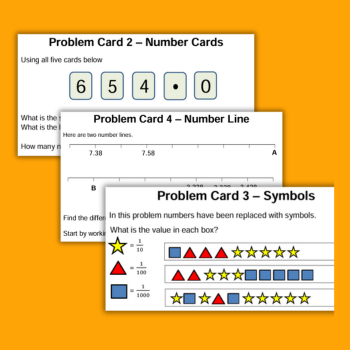Use this set of problem cards to get children thinking about place value with decimals.
What is decimal place value?
Decimal place value is a fundamental concept in mathematics, crucial for understanding numbers and performing arithmetic operations. It’s a key part of the Key Stage 3 (KS3) curriculum for pupils aged 11 to 14, and refers to the position of digits in a decimal number, determining their value based on powers of 10. For instance, in the number 345.678:
- Hundreds: 3 (300)
- Tens: 4 (40)
- Units (Ones): 5 (5)
- Tenths: 6 (0.6)
- Hundredths: 7 (0.07)
- Thousandths: 8 (0.008)
The KS3 Maths curriculum aims to:
- Develop fluency in mathematics through varied practice.
- Foster conceptual understanding and accurate application of knowledge.
- Enhance mathematical reasoning and problem-solving skills.
Key curriculum components
- Number and place value:
- Understanding place value for decimals and integers.
- Using relationships between operations, including inverse operations.
- Fractions, decimals, and percentages:
- Solving problems involving fractions, decimals, and percentages.
- Converting between these forms.
- Operations with decimals:
- Performing arithmetic operations with decimals.
- Understanding the order of operations.
Practical applications for decimal place value
Students use decimal place value to:
- Perform calculations with decimals, essential for handling money and measurements.
- Compare and order decimals for data analysis.
- Understand the effects of multiplying and dividing by powers of 10, aiding in scientific notation.
Teaching strategies
Effective teaching strategies include:
- Visual Aids: Using charts and blocks to represent decimal numbers.
- Real-life Contexts: Applying decimals in practical scenarios like currency and measurement.
- Interactive Activities: Engaging students with games and digital tools.
- Practice and Reinforcement: Providing worksheets and problem-solving exercises.
Mastering decimal place value equips KS3 students with a strong foundation for advanced mathematical concepts, preparing them for KS4 and beyond.
Influenced, inspired and informed by the work of leading maths researchers and practitioners across the world, White Rose Maths brings together a team of highly experienced and passionate maths teaching experts to train, guide, help and support all those who want to make change happen in their schools. You can find more resources at whiterosemaths.com/schemes-of-learning and follow on Twitter at @whiterosemaths.
We also have Key Stage 3 maths worksheets for the whole curriculum.














